Measuring Guide
Our measuring guide below is how we measure our clothing for bottoms and tops. The best way to ensure the correct size is to measure one of your current pairs of bottoms/tops that fit you well, and compare to the sizing charts on each product page. If you have additional sizing questions, feel free to e-mail us or reach out to us on Instagram and we will help you out. Click on "Bottoms" or "Tops" to view our measuring guide for each article of clothing.
Bottoms: Denim/Trousers/Pants
We provide most of the traditional measurements you typically see, but we include two thigh measurements-one measurement from the crotch seam and a second measurement from two inches down. We tend to find the majority of sizing issues-when the waist is sized correctly-arises from the thigh area being too tight. Using two measurements, we think you will have a better idea of how the pants will fit compared to your current best fitting pair.
Note: Unless you want a very skinny fit, we recommend the thigh measurement of the pants be at least 0.1” larger than the circumference of your actual thigh circumference.
WaistTo measure the waist, pull the denim tight at the waist band to align the front and rear as much as possible (the front waistband usually sags below the rear, as seen in the first photo below, which results in a smaller measurement by 0.5-1"). Instead, pull the waistband taut so that the front and rear waist are level, resulting in a more accurate waist measurement.
Inaccurate measurement, laid flat at rest with waistbands not held tight:

Accurate measurement, with hands holding the waistbands tight:

To measure the front rise, place the measuring tape at the crotch seam and measure straight up towards the middle of the front waistband.

To measure the back rise, place the measuring tape at the crotch seam and measure straight up to the center of the back waistband. You may need to hold the back waistband and pull the crotch seam down and out to more easily measure from the crotch seam.

To measure the thigh (from the crotch), place the measuring tape at the crotch seam and measure directly across the leg such that the tape is perpendicular to the outseam.

To measure the thigh (2” down), first measure two inches down from the crotch and make note of this point. Then, place the measuring tape at the point 2” down from the crotch and measure directly across the leg such that the tape is perpendicular to the outseam.

To measure the knee, first measure 13” down from the crotch and make note of this point.

Place the measuring tape at the point 13” down from the crotch and measure directly across the leg such that the tape is perpendicular to the outseam.

To measure the hem, place the measuring tape on one edge at the leg opening and measure across.

To measure the inseam, make sure the leg is pulled out straight and place the measuring tape at the croth and measure along the contour of the legs down to the opening.

Tops: Shirts/Tees/Jackets
Sizing for tops can vary widely between various brands and even within the same brand for different styles. We tend to find that the best fitting shirts are ones where the shoulder measurement is equal or slightly larger than your actual shoulder measurement. The second most important is usually the chest measurement. Based on these two measurements compared to your actual body measurement, as well as comparisons to your best fitting shirt, you should be able to identify your correct size.
ChestTo measure the chest, pull the shirt tight across the chest and measure from pit to pit. It may be helpful to raise the arms out of the way.
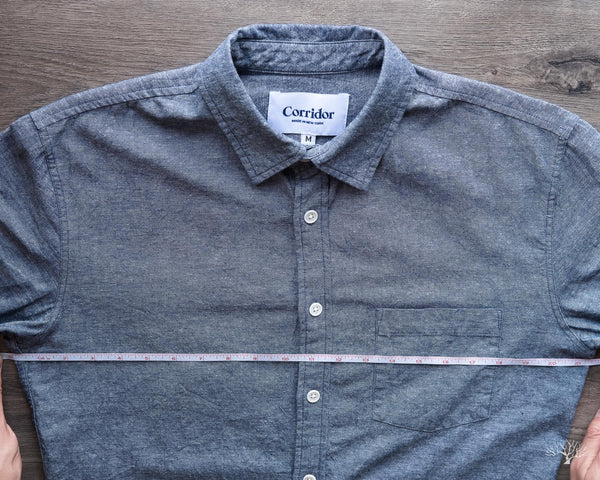
To measure the bottom (hem), pull the shirt tight across the bottom and measure from one bottom edge to the other.
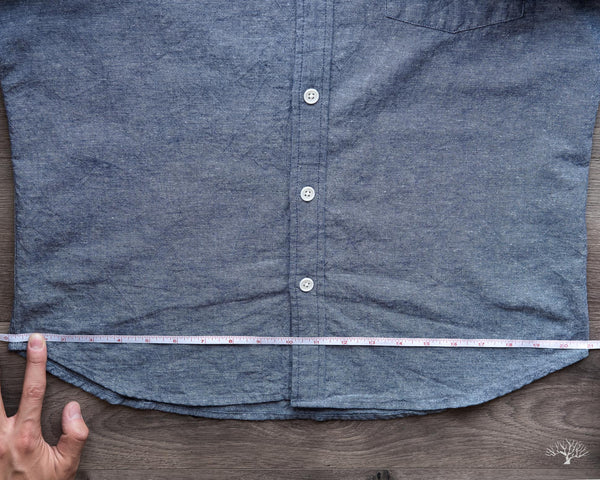
To measure the shoulders, ensure the top section of the shirt is flat and pulled tight, and measure from one shoulder seam to the other.
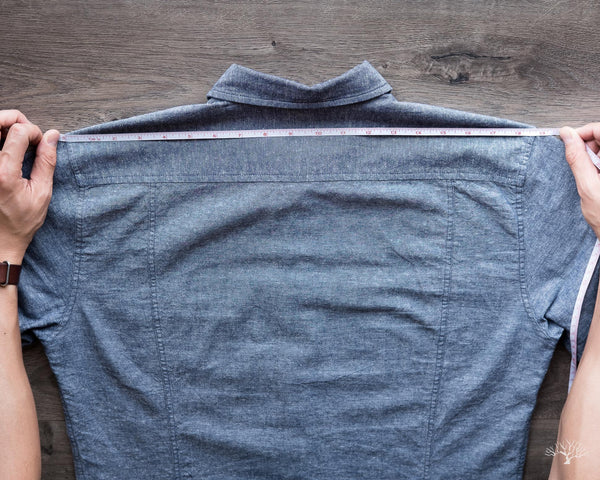
To measure the sleeves, pull the arm straight out and measure from the shoulder seam down to the end of the cuff.
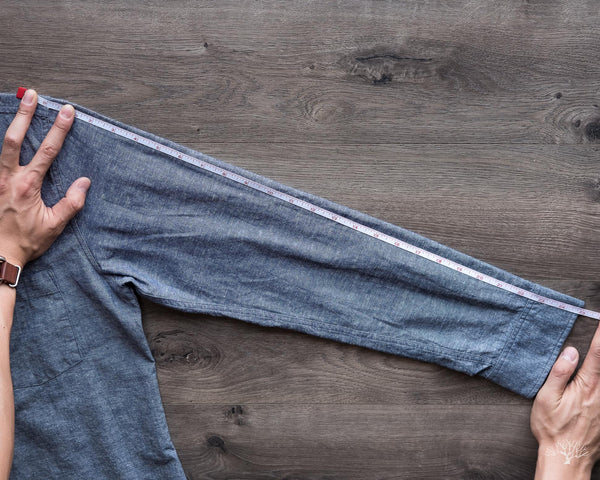
Ensure you measure from the shoulder seam.
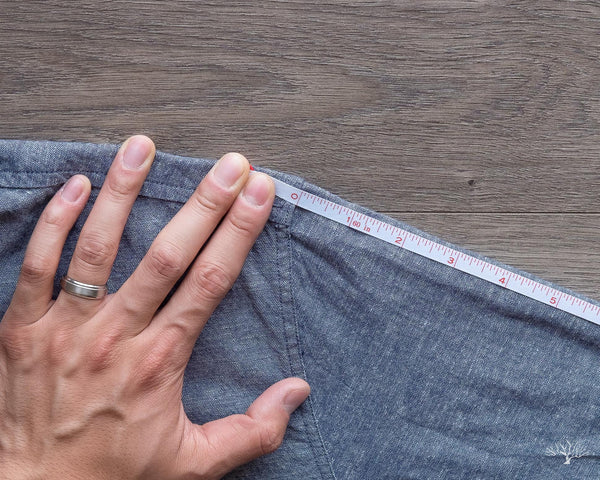
To measure the [vertical] length of the shirt, lay the shirt flat on its front with the backside facing you. Measure from the center of the collar seam to the bottom of the shirt.

Ensure you measure from the collar seam.

Boots
We currently carry Viberg boots as our only footwear brand, with their 1035 Last as our primary last we offer. The 1035 Last is a tweener between Viberg's 2030 and 2040 lasts. It takes the sleekness of the 2030 and combines it with the additional room in the toe box of the 2040. The result is what we consider the perfect combination of looks and fit for many folks, especially those who just don't know that their toes appreciate the extra width. Vibergs generally run one size larger than your normal sneaker sizes and your Brannock size. As such, most people size down one from their Brannock, +/- 0.5 depending on your feet width, as well as the specific last of the boot.
1035 Last (Service Boot):
- General: Size down one from your Brannock if you are D width or smaller. However, if you are E width or larger, or prefer a roomier fit, size down 1/2 from your Brannock.
- Additional Considerations: Take into account whether you would like to wear thinner socks, or prefer a slightly snug fit (then you may want to go with one size down rather than 1/2); versus, primarily wearing thicker socks or prefer slightly roomier fit (then go with 1/2 size down). From our experience, only about 15-20% of our customers go with 1/2 size down, versus a full size down, so it is not as common.
1035 Last (145 Oxford):
- General: Similar advice as the 1035 Last Service Boot, however more folks may want to size down one from your Brannock, rather than just 1/2 (even if you size down 1/2 for the service boot).
- Additional Considerations: The 145 Oxford may feel like they have a tad more room and heel slip as you don't have the shaft of the boot extending up and around your ankles to make your feet feel more secure. Additionally, given that it is an oxford, you may entertain the idea of wearing it with thin socks or no-show socks, which would benefit from a tighter fit. However, if you maintain wearing thick socks, size the same as the service boot. In almost all cases, we do not recommend sizing down 1.5 from Brannock.
2020 Last:
- General: Compared to the 1035 Last, the 2020 Last has a narrower toe that gradually slopes in based on the anatomical shape of your feet. The waist is accordingly slimmed to the anatomy of your feet. We generally recommend sizing down one from your Brannock if you have narrow-to-medium width feet (D width or smaller). Viberg considers this last a proper D width toebox, so those who have wide feet (E width or larger) may want to size down 1/2 from Brannock.
- Additional Considerations: Given this new last, sizing is varied quite a bit and we are still learning what the best general recommendation is. That said, if you feel like your current 2030/1035 Service Boot is on the tight/snug end, you may consider sizing up 1/2 for the 2020 Last. If your current 2030/1035 Service Boot is on the relaxed/spacious end, you may stay the same size for a proper anatomical fit.
2030 Last:
- General: Compared to the 1035 Last, the 2030 Last has a narrower toe (almond-shaped) and low profile that gives it a sleeker look and feel. We generally recommend sizing down one from your Brannock. Viberg considers this last appropriate for an E width feet, however those who prefer a wider toe box or need more room may consider taking a half size up (or 1/2 down from Brannock).
- Additional Considerations: The Country Boot style may feel like they have a tad more room due to the specific style when compared to their Service Boot. If you are inbetween sizes, you may consider sizing down half, especially if you currently only size down 1/2 from Brannock for your Service Boots. However, we would not recommend sizing down 1.5 down from Brannock if you are already 1 down from Brannock.
41464 Last (also known as 2050):
- General: Size down one from your Brannock if you are D width or smaller. However, if you are E width or larger, or prefer a roomier fit, size down 1/2 from your Brannock. Most people will size the same in the 41464 (2050) Last as they do in the 2030, which is also one down from Brannock.
- Additional Considerations: The 41464 Last is built for the Chelsea and Side Zip boot, and features an almond shaped toe and a higher instep. This is Viberg's narrowest last; accordingly, some people may find themselves sizing up 1/2 from their 2030/1035 size, if they have a wide foot, prefer a more generous fit, or if their 2030/1035 size fits snug.
